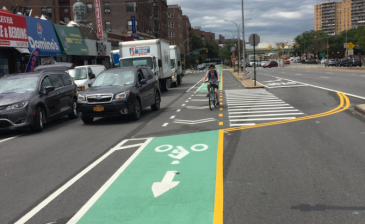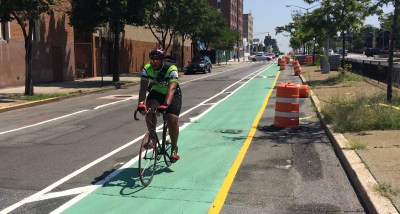Boulevard of Life, Phase 1: DOT Will Add Protected Bike Lanes to Queens Blvd

A key section of Queens Boulevard will get protected bike lanes this summer, DOT announced today. The improvements are the first phase of a broader $100 million overhaul that will encompass seven miles of the notoriously dangerous street.
Queens Boulevard is one of the only continuous east-west connections in the borough, making it a natural biking route, but it is designed for high-speed traffic. Dozens of people are seriously injured or killed each year at its complex intersections.
The initial DOT project calls for bikeways to be striped on the boulevard’s service roads between Roosevelt Avenue and 73rd Street by August. The bike lanes will later be cast in concrete as part of a total street reconstruction. Designs for future sections of Queens Boulevard, stretching seven miles east to Union Turnpike, will be unveiled after a series of public workshops.
DOT launched its Queens Boulevard planning process in January with a well-attended workshop in Woodside. Earlier this month, Families For Safe Streets and Transportation Alternatives rallied outside Queens Borough Hall to call on DOT to swiftly implement changes.
Advocates have been campaigning for a protected bike lane on Queens Boulevard for many years.
Lizi Rahman lost her son Asif, 22, when he was hit and killed by a truck driver in 2008 while riding his bicycle on Queens Boulevard at 55th Road. “We have to get a bike lane on Queens Boulevard. It might not bring my son back, but I would know that my son died for a good cause,” she said at a demonstration later that year. “I will do this for him and it will help save the other bikers in the future.”
Today, Rahman said she is “ecstatic” to hear about the bike lane plan. “I have been driving on Queens Boulevard for a long time and never really noticed, but after his death I noticed that there wasn’t a bike lane,” she said. “It’s a little bit emotional… I’d really like the bike lane to be named after Asif.”
From 2009 to 2013, six people, including two pedestrians, were killed on the 1.3 miles that will be redesigned first, making it the deadliest stretch of Queens Boulevard, according to DOT.
Much of the design’s success will hinge on imposing order on Queens Boulevard’s chaotic intersections and the unruly transitions between its central roadway and service roads. DOT said it aims to keep through traffic in the center lanes, reducing the tendency of drivers to cut back and forth to the service lanes to avoid congestion. Instead of “slip lanes” that allow drivers to access the service roads at speed, the design calls for right-turn lanes with stop signs carved out of the medians. The medians would also be widened to include linear walkways. Cross-sections of the plan show that it will not remove car travel lanes.
The redesign and full reconstruction of Queens Boulevard are part of the de Blasio administration’s Vision Zero “Great Streets” initiative, along with rebuilds of the Grand Concourse, Atlantic Avenue, and Brooklyn’s Fourth Avenue.
DOT is presenting the plan in detail to the Queens Community Board 2 transportation committee at 6:30 p.m. tonight.


